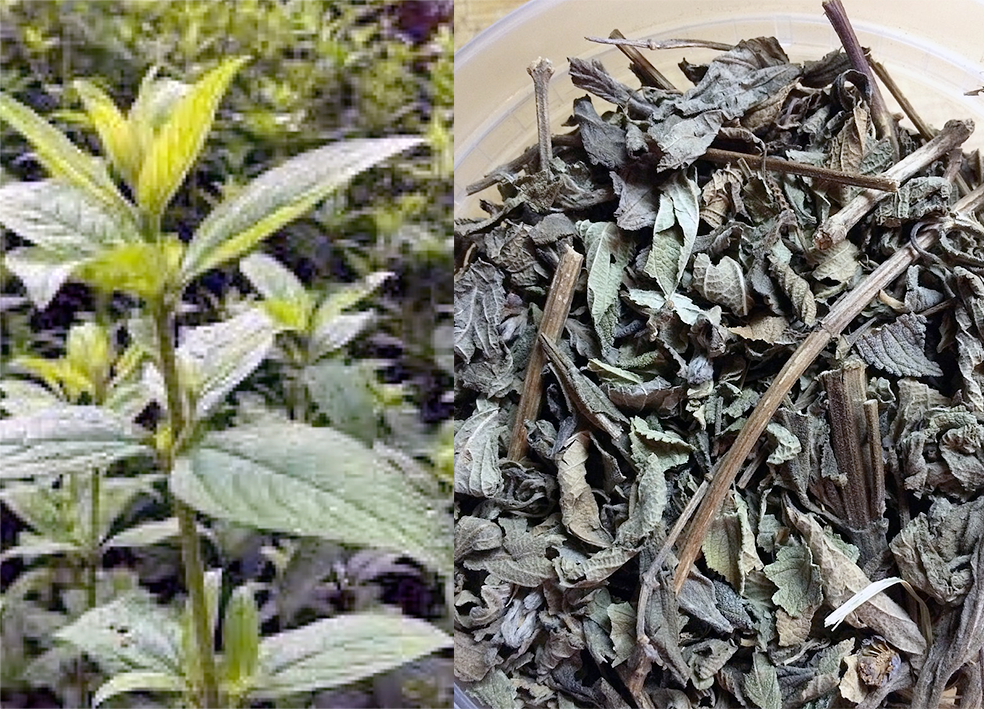 Koseret, Lippia
abyssinica var.
koseret, whole
plant (left) and the
dried leaves used as
an herb (right).
Koseret, Lippia
abyssinica var.
koseret, whole
plant (left) and the
dried leaves used as
an herb (right).
Welcome to the summary page for FabulousFusionFood's Herb guide to Koseret along with all the Koseret containing recipes presented on this site, with 0 recipes in total.
e This is a continuation of an entire series of pages that will, I hope, allow my visitors to better navigate this site. As well as displaying recipes by name, country and region of origin I am now planning a whole series of pages where recipes can be located by meal type and main ingredient. This page gives a listing of all the Cornish recipes added to this site.
These recipes, all contain Koseret as a major herb flavouring.
Lippia abyssinica var. koseret or koseret (Amharic: ኮሰረት, romanized: koserēt), is a species of flowering plant in the verbena family, Verbenaceae. It is endemic to Ethiopia but cultivated throughout tropical African countries. The specific epithet abyssinica derives from Latin and means 'of or from Ethiopia (Abyssinia)'.
Koseret is also known as Butter Clarifying Herb, kosearut, lemon herb, Gambey tea bush, and Gambia(n) tea bush. The plant grows as a 3m tall shrubby herb[6] at 1600–2000 m altitude in Ethiopia. It has hairy leaves and small flowers that are purple or pink. It is dried and used as an herb in Ethiopian cuisine. The smell is camphorous and minty.[16] Some describe its flavor as being similar to basil, but it is not closely related to that herb (they are merely in the same order, Lamiales). Koseret is closely related to the herb Mexican oregano (not to be confused with oregano), sharing the same genus Lippia. It is commonly used in making the spiced oils niter kibbeh where in addition to flavouring the oils or butter it acts as a preservative.
It is also used in ye'qimem zeyet and the spice mix afrinj. As these preparations are almost ubiquitous in Ethiopian cookery, koseret then flavours many common dishes, such as kitfo. In Democratic Republic of the Congo and Republic of the Congo it is eaten as a potherb. In west Africa, notably The Gambia, it is brewed into a tisane as a substitute for tea.
e This is a continuation of an entire series of pages that will, I hope, allow my visitors to better navigate this site. As well as displaying recipes by name, country and region of origin I am now planning a whole series of pages where recipes can be located by meal type and main ingredient. This page gives a listing of all the Cornish recipes added to this site.
These recipes, all contain Koseret as a major herb flavouring.
Lippia abyssinica var. koseret or koseret (Amharic: ኮሰረት, romanized: koserēt), is a species of flowering plant in the verbena family, Verbenaceae. It is endemic to Ethiopia but cultivated throughout tropical African countries. The specific epithet abyssinica derives from Latin and means 'of or from Ethiopia (Abyssinia)'.
Koseret is also known as Butter Clarifying Herb, kosearut, lemon herb, Gambey tea bush, and Gambia(n) tea bush. The plant grows as a 3m tall shrubby herb[6] at 1600–2000 m altitude in Ethiopia. It has hairy leaves and small flowers that are purple or pink. It is dried and used as an herb in Ethiopian cuisine. The smell is camphorous and minty.[16] Some describe its flavor as being similar to basil, but it is not closely related to that herb (they are merely in the same order, Lamiales). Koseret is closely related to the herb Mexican oregano (not to be confused with oregano), sharing the same genus Lippia. It is commonly used in making the spiced oils niter kibbeh where in addition to flavouring the oils or butter it acts as a preservative.
It is also used in ye'qimem zeyet and the spice mix afrinj. As these preparations are almost ubiquitous in Ethiopian cookery, koseret then flavours many common dishes, such as kitfo. In Democratic Republic of the Congo and Republic of the Congo it is eaten as a potherb. In west Africa, notably The Gambia, it is brewed into a tisane as a substitute for tea.
The alphabetical list of all Koseret recipes on this site follows, (limited to 100 recipes per page). There are 0 recipes in total:
Page 1 of 1
Page 1 of 1